Abstract
Some biological consequences of strand breakage in biologically active single- and double-stranded plasmid and viral DNA are examined. A double-strand break in DNA produced by restriction-endonucleases in aqueous solution is not a 100% lethal damage. The survival depends strongly on the structure of the end groups. Evidence is presented that survival is the result of a balance between degradation and repair. The enzymatically produced double-strand break (dsb) is a potentially lethal damage similar to the irradiation-produced dsb in cells. Results with double-stranded biologically active DNA treated either with gamma-rays, heat, pancrease nuclease or UV-light in aqueous solution suggest that a single-strand damage is also a potentially lethal damage. Mechanisms for conversion of single-strand damage to lethal events are discussed.
Full text
PDF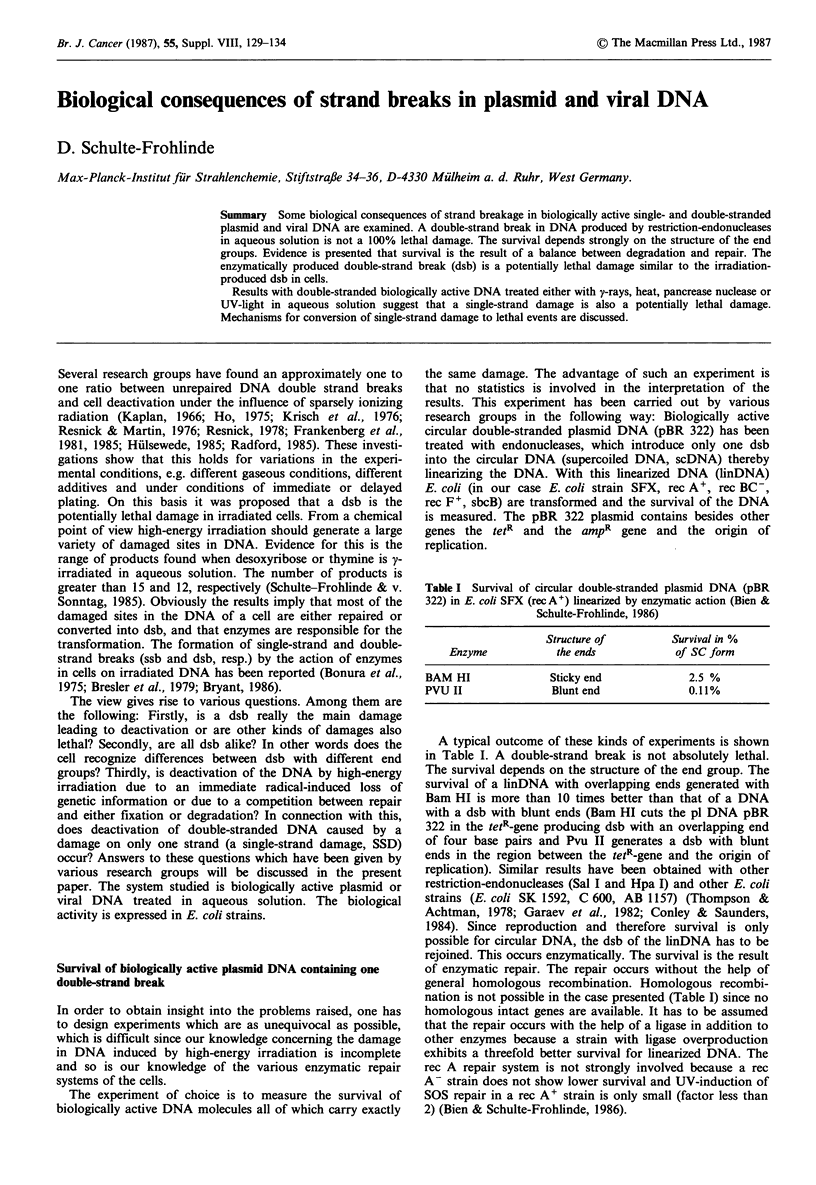
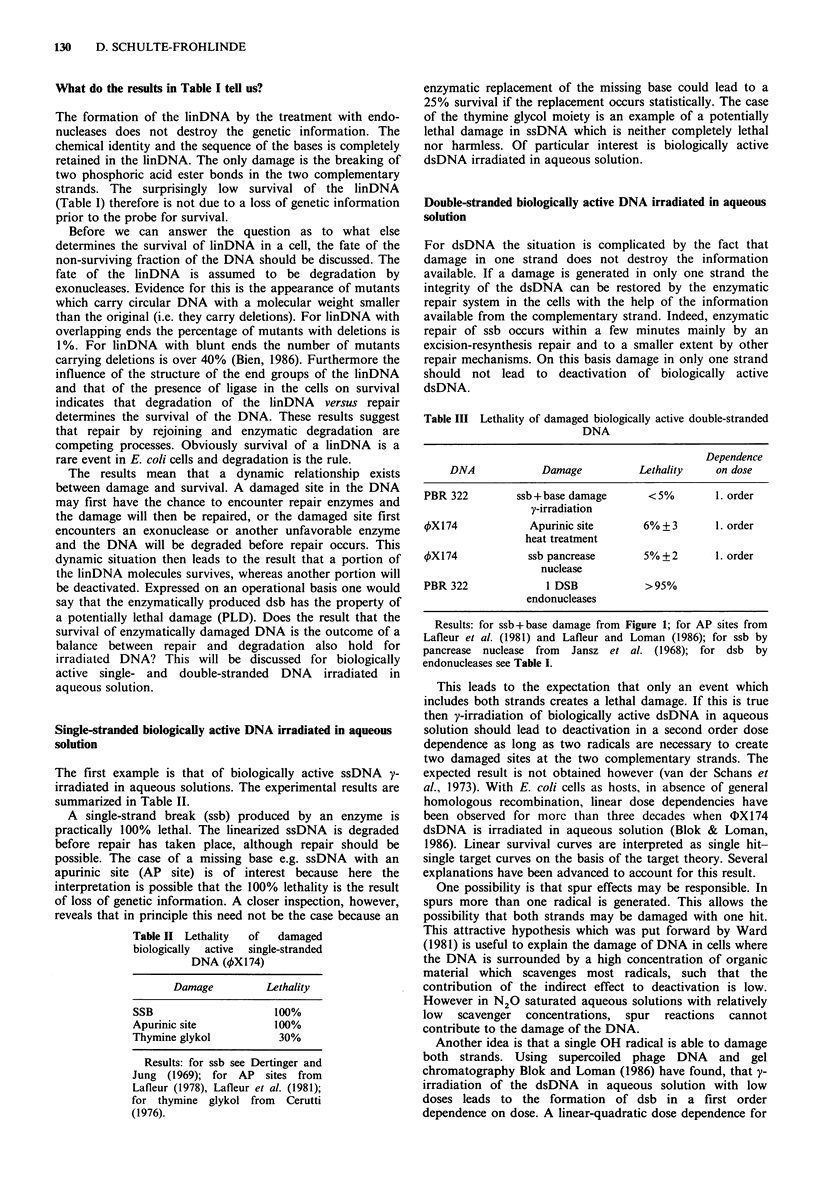
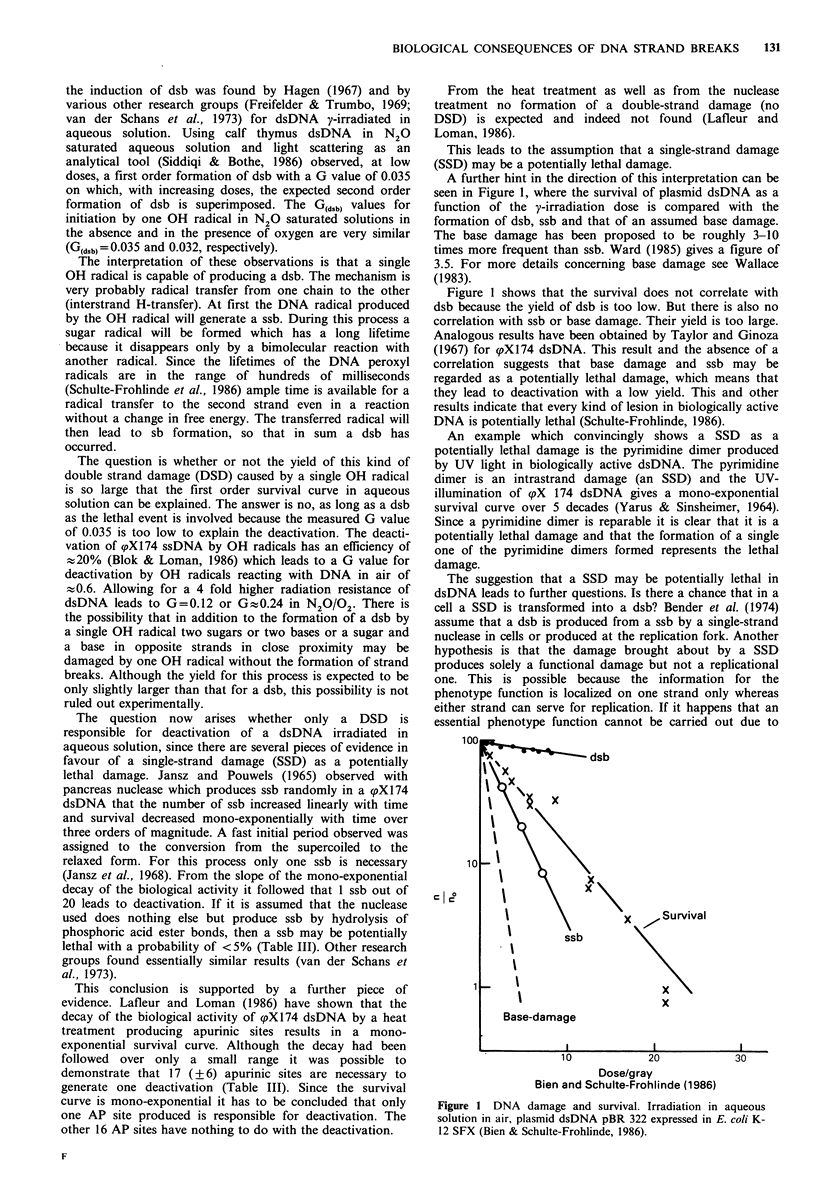
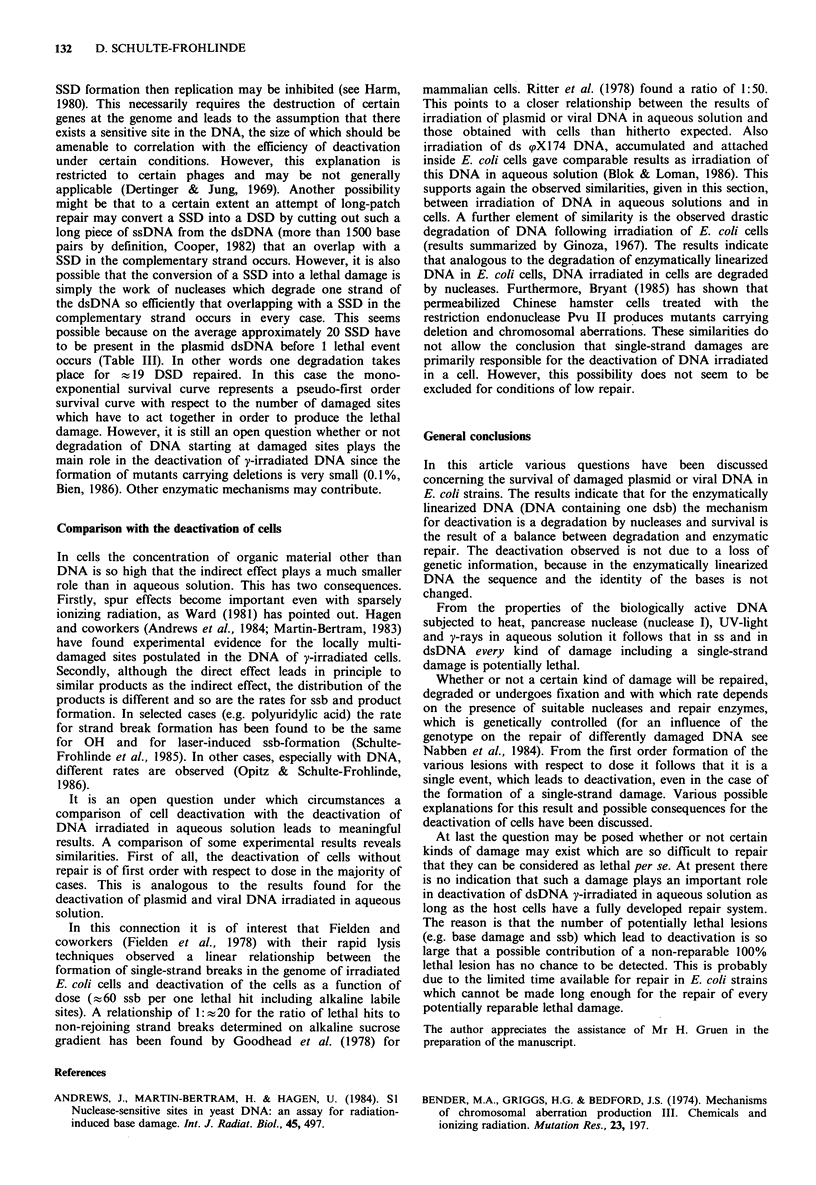
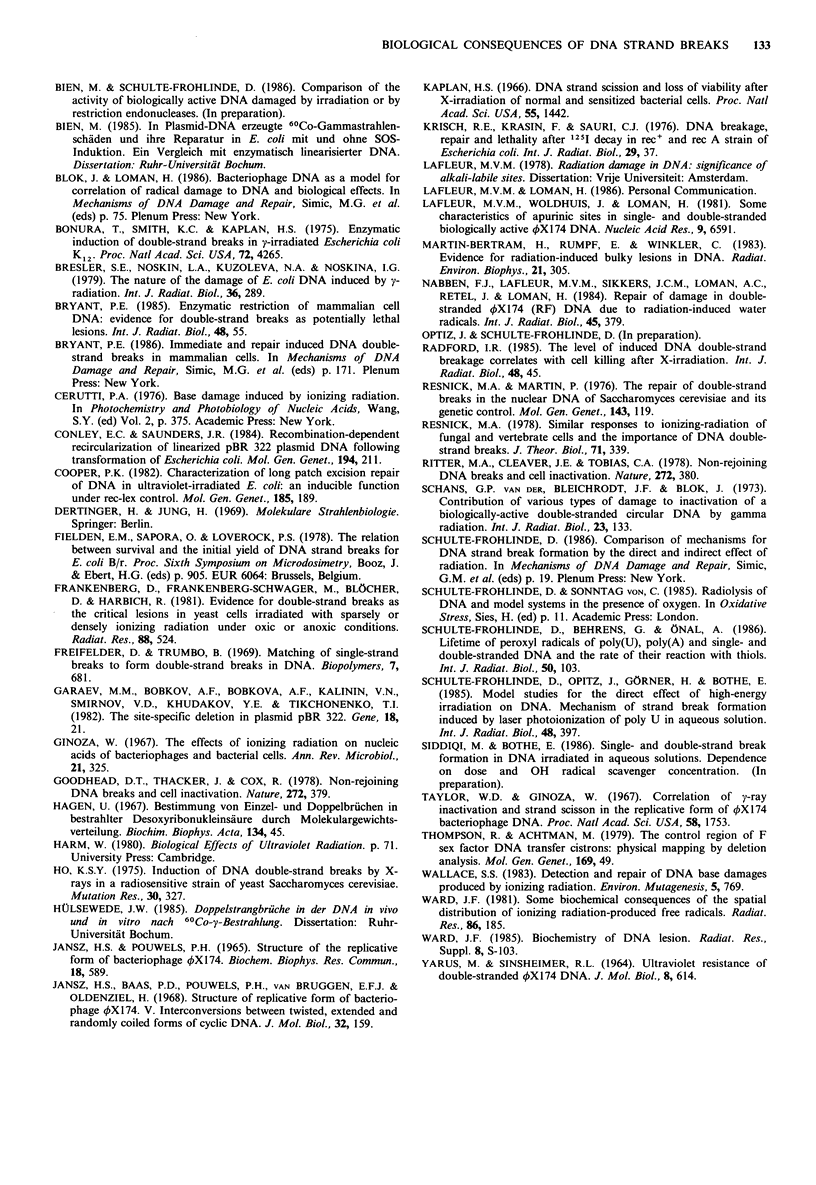
Selected References
These references are in PubMed. This may not be the complete list of references from this article.
- Andrews J., Martin-Bertram H., Hagen U. S1 nuclease-sensitive sites in yeast DNA: an assay for radiation-induced base damage. Int J Radiat Biol Relat Stud Phys Chem Med. 1984 May;45(5):497–504. doi: 10.1080/09553008414550701. [DOI] [PubMed] [Google Scholar]
- Bender M. A., Griggs H. G., Bedford J. S. Mechanisms of chromosomal aberration production. 3. Chemicals and ionizing radiation. Mutat Res. 1974 May;23(2):197–212. doi: 10.1016/0027-5107(74)90140-7. [DOI] [PubMed] [Google Scholar]
- Bonura T., Smith K. C., Kaplan H. S. Enzymatic induction of DNA double-strand breaks in gamma-irradiated Escherichia coli K-12. Proc Natl Acad Sci U S A. 1975 Nov;72(11):4265–4269. doi: 10.1073/pnas.72.11.4265. [DOI] [PMC free article] [PubMed] [Google Scholar]
- Bresler S. E., Noskin L. A., Kuzovleva N. A., Noskina I. G. The nature of the damage to Escherichia coli DNA induced by gamma-irradiation. Int J Radiat Biol Relat Stud Phys Chem Med. 1979 Sep;36(3):289–300. doi: 10.1080/09553007914551061. [DOI] [PubMed] [Google Scholar]
- Bryant P. E. Enzymatic restriction of mammalian cell DNA: evidence for double-strand breaks as potentially lethal lesions. Int J Radiat Biol Relat Stud Phys Chem Med. 1985 Jul;48(1):55–60. doi: 10.1080/09553008514551061. [DOI] [PubMed] [Google Scholar]
- Bryant P. E. Immediate and repair induced DNA double strand breaks in mammalian cells. Basic Life Sci. 1986;38:171–180. doi: 10.1007/978-1-4615-9462-8_18. [DOI] [PubMed] [Google Scholar]
- Conley E. C., Saunders J. R. Recombination-dependent recircularization of linearized pBR322 plasmid DNA following transformation of Escherichia coli. Mol Gen Genet. 1984;194(1-2):211–218. doi: 10.1007/BF00383519. [DOI] [PubMed] [Google Scholar]
- Cooper P. K. Characterization of long patch excision repair of DNA in ultraviolet-irradiated Escherichia coli: an inducible function under rec-lex control. Mol Gen Genet. 1982;185(2):189–197. doi: 10.1007/BF00330785. [DOI] [PubMed] [Google Scholar]
- Frankenberg D., Frankenberg-Schwager M., Blöcher D., Harbich R. Evidence for DNA double-strand breaks as the critical lesions in yeast cells irradiated with sparsely or densely ionizing radiation under oxic or anoxic conditions. Radiat Res. 1981 Dec;88(3):524–532. [PubMed] [Google Scholar]
- Garaev M. M., Bobkov A. F., Bobkova A. F., Kalinin V. N., Smirnov V. D., Khudakov YuE, Tikchonenko T. I. The site-specific deletion in plasmid pBR322. Gene. 1982 Apr;18(1):21–28. doi: 10.1016/0378-1119(82)90052-x. [DOI] [PubMed] [Google Scholar]
- Ginoza W. The effects of ionizing radiation on nucleic acids of bacteriophages and bacterial cells. Annu Rev Microbiol. 1967;21:325–368. doi: 10.1146/annurev.mi.21.100167.001545. [DOI] [PubMed] [Google Scholar]
- Goodhead D. T., Thacker J., Cox R. Non-rejoining DNA breaks and cell inactivation. Nature. 1978 Mar 23;272(5651):379–380. doi: 10.1038/272379a0. [DOI] [PubMed] [Google Scholar]
- Ho K. S. Induction of DNA double-strand breaks by X-rays in a radiosensitive strain of the yeast Saccharomyces cerevisiae. Mutat Res. 1975 Dec;30(3):327–334. [PubMed] [Google Scholar]
- JANSZ H. S., POUWELS P. H. STRUCTURE OF THE REPLICATIVE FORM OF BACTERIOPHAGE 0X174. Biochem Biophys Res Commun. 1965 Feb 17;18:589–594. doi: 10.1016/0006-291x(65)90795-3. [DOI] [PubMed] [Google Scholar]
- Jansz H. S., Baas P. D., Pouwels P. H., van Bruggen E. F., Oldenziel H. Structure of the replicative form of bacteriophage phi X174. V. Interconversions between twisted, extended and randomly coiled forms of cyclic DNA. J Mol Biol. 1968 Mar 14;32(2):159–168. doi: 10.1016/0022-2836(68)90001-6. [DOI] [PubMed] [Google Scholar]
- Kaplan H. S. DNA-strand scission and loss of viability after x irradiation of normal and sensitized bacterial cells. Proc Natl Acad Sci U S A. 1966 Jun;55(6):1442–1446. doi: 10.1073/pnas.55.6.1442. [DOI] [PMC free article] [PubMed] [Google Scholar]
- Krisch R. E., Krasin F., Sauri C. J. DNA breakage, repair and lethality after 125I decay in rec+ and recA strains of Escherichia coli. Int J Radiat Biol Relat Stud Phys Chem Med. 1976 Jan;29(1):37–50. doi: 10.1080/09553007614551541. [DOI] [PubMed] [Google Scholar]
- Lafleur M. V., Woldhuis J., Loman H. Some characteristics of apurinic sites in single- and double-stranded biologically active phi X174 DNA. Nucleic Acids Res. 1981 Dec 11;9(23):6591–6599. doi: 10.1093/nar/9.23.6591. [DOI] [PMC free article] [PubMed] [Google Scholar]
- Martin-Bertram H., Rumpf E., Winkler C. Evidence for radiation-induced bulky lesions in DNA. Radiat Environ Biophys. 1983;21(4):305–307. doi: 10.1007/BF01341467. [DOI] [PubMed] [Google Scholar]
- Nabben F. J., Lafleur M. V., Sikkers J. C., Loman A. C., Retèl J., Loman H. Repair of damage in double-stranded phi X174 (RF) DNA due to radiation-induced water radicals. Int J Radiat Biol Relat Stud Phys Chem Med. 1984 Apr;45(4):379–388. doi: 10.1080/09553008414550521. [DOI] [PubMed] [Google Scholar]
- Radford I. R. The level of induced DNA double-strand breakage correlates with cell killing after X-irradiation. Int J Radiat Biol Relat Stud Phys Chem Med. 1985 Jul;48(1):45–54. doi: 10.1080/09553008514551051. [DOI] [PubMed] [Google Scholar]
- Resnick M. A., Martin P. The repair of double-strand breaks in the nuclear DNA of Saccharomyces cerevisiae and its genetic control. Mol Gen Genet. 1976 Jan 16;143(2):119–129. doi: 10.1007/BF00266917. [DOI] [PubMed] [Google Scholar]
- Resnick M. A. Similar responses to ionizing radiation of fungal and vertebrate cells and the importance of DNA doublestrand breaks. J Theor Biol. 1978 Apr 6;71(3):339–346. doi: 10.1016/0022-5193(78)90164-9. [DOI] [PubMed] [Google Scholar]
- Schulte-Frohlinde D., Behrens G., Onal A. Lifetime of peroxyl radicals of poly(U), poly(A) and single-and double-stranded DNA and the rate of their reaction with thiols. Int J Radiat Biol Relat Stud Phys Chem Med. 1986 Jul;50(1):103–110. doi: 10.1080/09553008614550481. [DOI] [PubMed] [Google Scholar]
- Schulte-Frohlinde D., Opitz J., Görner H., Bothe E. Model studies for the direct effect of high-energy irradiation on DNA. Mechanism of strand break formation induced by laser photoionization of poly U in aqueous solution. Int J Radiat Biol Relat Stud Phys Chem Med. 1985 Sep;48(3):397–408. doi: 10.1080/09553008514551401. [DOI] [PubMed] [Google Scholar]
- Taylor W. D., Ginoza W. Correlation of gamma-ray inactivation and strand scission in the replicative form of phi-X174 bacteriophage DNA. Proc Natl Acad Sci U S A. 1967 Oct;58(4):1753–1757. doi: 10.1073/pnas.58.4.1753. [DOI] [PMC free article] [PubMed] [Google Scholar]
- Thompson R., Achtman M. The control region of the F sex factor DNA transfer cistrons: physical mapping by deletion analysis. Mol Gen Genet. 1979 Jan 16;169(1):49–57. doi: 10.1007/BF00267544. [DOI] [PubMed] [Google Scholar]
- Wallace S. S. Detection and repair of DNA base damages produced by ionizing radiation. Environ Mutagen. 1983;5(5):769–788. doi: 10.1002/em.2860050514. [DOI] [PubMed] [Google Scholar]
- Ward J. F. Some biochemical consequences of the spatial distribution of ionizing radiation-produced free radicals. Radiat Res. 1981 May;86(2):185–195. [PubMed] [Google Scholar]
- YARUS M., SINSHEIMER R. L. THE U.V.-RESISTANCE OF DOUBLE-STRANDED PHIX174 DNA. J Mol Biol. 1964 Apr;8:614–615. doi: 10.1016/s0022-2836(64)80018-8. [DOI] [PubMed] [Google Scholar]
- van der Schans G. P., Bleichrodt J. F., Blok J. Contribution of various types of damage to inactivation of a biologically-active double-stranded circular DNA by gamma-radiation. Int J Radiat Biol Relat Stud Phys Chem Med. 1973 Feb;23(2):133–150. doi: 10.1080/09553007314550151. [DOI] [PubMed] [Google Scholar]


